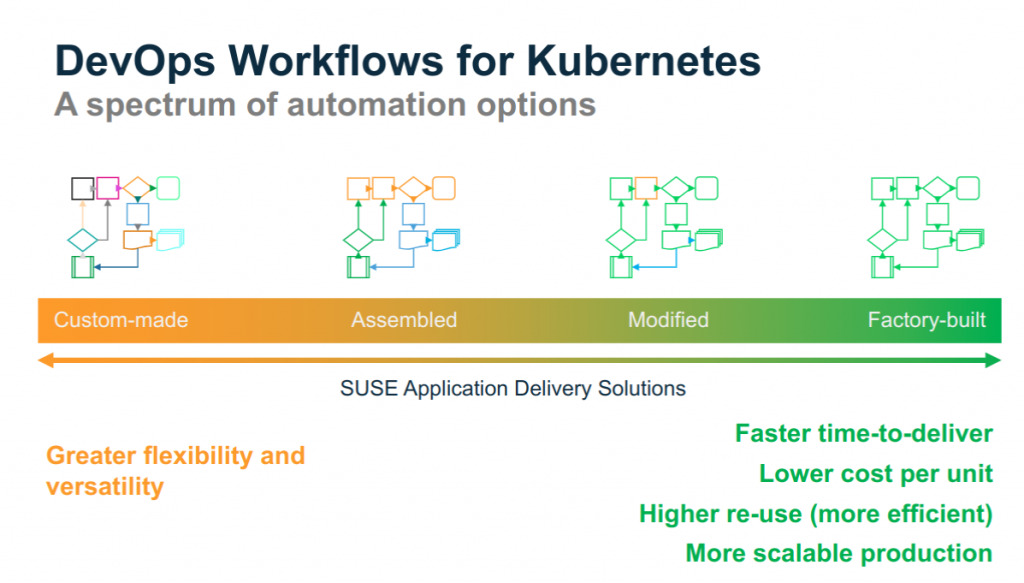The essential Ingredient for every Enterprise
Less than five years old, Kubernetes has already become the de facto container management system worldwide. In 2018 Forrester’s cloud predictions declared Kubernetes to be the victor in the “war for container orchestration dominance.” Since then its popularity has only continued to grow and CIOs across every sector now consider it tobe the gold standard for container management. In particular when it comes to supporting DevOps within their business.
This popularity is no surprise given the benefits of the technology. Kubernetes groups application containers into logical “packages” for simple, fast management and discovery. It also automates the deployment and scaling of containerised applications. Not quite a true platform in itself, Kubernetes can be combined with additional elements to provide the ease of use of Platform-as-a-Service for developers, with the adaptability of Infrastructure-as-a-Service to make it easier to move workloads across infrastructure providers. Modern enterprise use containers as an increasingly important aspect of their business. But there are still those implementing container technology without Kubernetes. CIOs should consider the following three key reasons to embrace the industry standard:
Tech industry’s influence on Kubernetes
Developed as an open source project by Google in 2014, Kubernetes immediately benefitted from its creator’s heritage of employing the world’s best talent and its legacy of experience around providing software services at a large scale.
But it wasn’t just Google’s legacy that led to the rapid growth of the system. Kubernetes brought with it major benefits including its accessibility through major cloud providers like Azure, Amazon Web Services, and Google Cloud Platform. Being hosted and supported by the CloudNative Computing Foundation (CNCF) and The Linux Foundation also proved valuable. Association with bothfoundations helped the system gain credibility through its ability to continually improve through best practices and contributions from members, including SAP, AWS, SUSE, Google and more.
With such widespread support across the industry, Kubernetes eventually sparked the interest of enterprise vendors, which ultimately led it to where it is today – being a central component of innovation within the space.
Flexibility is the key
There is hardly an organisation today that does not deploy a combination of cloud and on-premises data centres. Thus IT needs the ability to easily and securely run and move workloads as well as share data between the various environments.

The unrivalled flexibility of Kubernetes makes it ideal for this hybrid environments: it can be implemented across cloud and on-premises, or even run as a service. As the system does not rely on a particular infrastructure, DevOps teams can build applications and then use Kubernetes to deploy them just as easily in the organisation’s data centre as in the public cloud.
From the latest cloud-native micro-services to a legacy application which has been migrated into containers, Kubernetes can handle practically any application. In a
nutshell: if an application works in containers, it will work smoothly on Kubernetes. Designed to support a wide range of workloads, Kubernetes also works well with stateof-the-art development technology, such as serverless architecture.
DevOps innovation at its best
Achieving business agility requires more than software and IT, yet applications are necessary to all companies’ success. The DevOps method is revolutionising application development and helping organisations to achieve business agility – in part because of the flexibility of containers.
Luckily, Kubernetes simplifies DevOps as it allows developers to package their applications into containers and be certain that the apps will process as well in production
environments as they would anywhere else. The platform removes a level of work for developers, specifically removing the need for them to spend time on scripting specific deployment, scaling and updating workflows. Because this is all done automatically – especially when put together with application platform technologies such as Cloud Foundry – there’s no need for developer input. Developers across the world have already started to see tangible success metrics when it comes to Kubernetes. One great example is in the case of Ancestry, the global leader in family history and consumer genomics. Faced with a website that had become quite cumbersome and time-consuming in its processing, the company needed a way to accelerate and become more agile in delivering its products and solution. Fast forward to today and it is working with rapid speeds, enabling it to make customer discoveries faster than ever before. Kubernetes is a critical component of application development and delivery solutions today. This ground-breaking technology will drive enterprise innovation now and in years to come. CIOs in need of achieving business agility should embrace Kubernetes for their businesses now to dramatically accelerate application delivery with containerized and cloud-native workloads.

